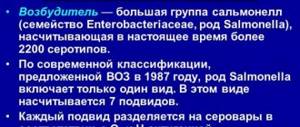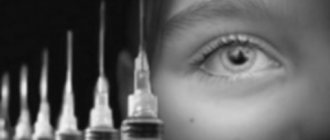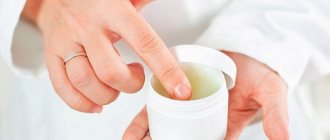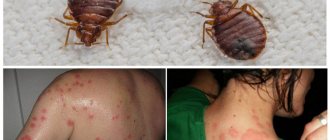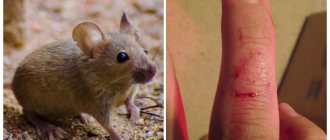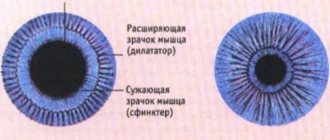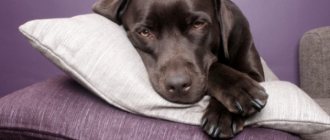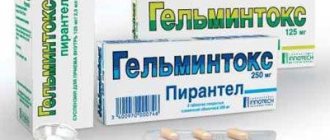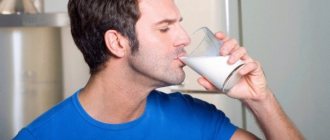Lice are probably the most famous parasites that feed on human blood. They can settle in your hair or clothes. The disease associated with the appearance of lice is called pediculosis, and lice bites are an integral part of this pathology. It is worth noting that the place where this parasite has embedded itself takes a long time to heal and itch, so you need to know how to deal with lice and alleviate the symptoms.
Symptoms of linen lice
The presence of parasites can only be determined by bites on the body. Insects feed on blood and eat in most cases at night, when a person is in bed. The process of food absorption lasts up to 3 minutes, the frequency of bites is several times a week. Linen lice, unlike head lice, do not live on the body; they crawl there only to feed. If there is no food source for 7 days, the insects die.
The parasite injects a special substance that prevents blood clotting. With frequent bites, an allergic reaction and inflammation develop. When scratching, an infection gets into the wound and ulcers appear. Therefore, the symptoms of linen lice on the skin depend on the stage of infection and the number of parasites.
Insects settle in linen, mattresses, and underwear. In places where the power source is closest. Externally they resemble a head louse. The body size of an adult is up to 5 mm, the body is translucent. Elastic chitinous cover, capable of stretching. Nits are white, oblong in shape, up to 2 mm. Lice lay eggs in linen, bedding, and folds of clothing.
Pubic lice. A big problem
Lice bites on a person can appear almost anywhere, including in the intimate area, as well as in the armpits. Parasites that live and reproduce in these places are called pubic parasites.
Symptoms of pubic lice are as follows:
- small red spots on underwear;
- nits found in pubic hair;
- constant itching in the intimate area;
- swelling of the skin in the pubic area or armpits.
It is worth noting that sometimes pubic lice crawl onto a person’s eyelashes. In this case, lice can already harm a person’s vision, since constant scratching of the skin in the eye area can lead, for example, to the formation of conjunctivitis.
Linen lice bites on the body, photo
Single bites are no different from a midge, mosquito, or bed bug. At the site of saliva injection, slight swelling and redness appear, and itching appears over time. There is a dark spot of dried blood in the center.
With severe infection, there are many spots, they are located chaotically, often merge into one huge spot or look like a rash. Insects bite in areas where blood vessels are located closer to the surface - legs, shoulders, back, arms, neck. Less often the stomach. Adults are not bitten on the head; in children, bites are found on the face. Parasites do not live in the scalp.
How does a louse bite? Process
So, what lice bites look like has already been sorted out. But how does this parasite do this?
When it gets into the hairy part of the body, the louse uses sharp stilettos that are located around its mouth. It is worth noting that fleas also have the same stylets, which is why their bites are often confused.
Next, the louse begins to move into the deeper layers of the skin until it reaches a blood vessel. That is why, when examining a louse, its body is often in a vertical position, and its head is completely recessed into the skin.
Simultaneously with the bite, the parasite injects a special enzyme into the blood. He doesn't let it curl up quickly.
In principle, there is no allergy to the parasite bite itself. Itching and inflammation can appear precisely because of the injected enzyme, which is a foreign body for the human body.
Adult louse bites are much more dangerous for humans, despite the fact that the larvae can also damage the skin. The fact is that there is very little of this same enzyme in the saliva of the larvae, which is why their bites are practically unnoticeable.
As for nits, they do not have sharp stilettos at all, so they cannot bite. However, patients with lice very often complain of itching, which is caused by nits.
What body lice bites look like on the body, photo
Lice that live in things, bedding, and clothing have several names - linen lice, body lice, clothing lice, clothing lice. Nests are formed by insects in folds of fabric, blankets, mattresses, and underwear, but there is no difference between these parasites.
The symptoms are similar. Infection can occur at any time of the year, therefore, if itchy spots or swellings are detected, it is necessary to examine the head and bed.
Strangers in our house
From time to time, outbreaks of the disease occur in one or another region of our country. This mainly happens in the summer-autumn period, when children return from camps, and adults return from vacation spots - little-known campsites, private boarding houses. You can also pick up insects somewhere on public transport if even one nit or adult individual accidentally falls on you from a carrier of the disease.
To live and develop normally, a linen louse must feed 3-4 times a day. It lives in folds and seams.
The adult hides in clothes that are rarely changed. Nits are deposited in the folds of linen, seams of pillows and sheets. The problem of mass infection is almost impossible to solve with regular washing - treatment with special preparations is required. If only one or two insects were noticed, it is enough to wash the clothes at maximum temperature and iron them well.
Linen bug bites, photo
Insects do not live in the wild; they live only in human habitation. Infection can occur at any time of the year. They get into the house with infected things or from neighbors through cracks in the wall, floor, sockets, wiring, ventilation shafts. They differ in appearance from linen fleas, but their lifestyle is similar.
Bedbugs settle closer to the sleeping area, but do not necessarily settle in the bed. These can be sockets, books, interior items, wallpaper, household appliances, and much more. They crawl out of their shelters at night and attack a sleeping person. Bites appear on the neck, shoulders, arms, back, legs. They often bite in open areas.
Adults feed once every 10 days, nymphs of different ages feed every 3 days. During the bite, a substance is injected that prevents blood clotting. Adult bedbugs contain pain-relieving components in their saliva, so people do not hear the bite itself. Symptoms appear in the morning.
Bed bugs pierce the skin in a certain sequence - 2 bites in the form of a path. There is inflammation, swelling, redness, and dried blood in the center. With severe infection, large spots and allergies form.
Danger to animals
Settling on the body of the host animal, the louse clings to the fur with the help of claws and sheds its wings. After the loss of wings, the flight muscles completely atrophy, so the parasite is no longer able to leave the animal. Living its entire life on the host’s body, the parasitic organism feeds on its blood.
One individual does not pose a strong danger to an artiodactyl, but many individuals that settle on the animal’s body gnaw into its flesh and drink blood, which leads to exhaustion and death of an elk, deer or other representative of artiodactyls, since every day each individual feeds on the blood of the owner approximately 18 times.
Linen flea bites
Small jumping creatures do not live in linen or clothes. They prefer to live under the floor, baseboards, in carpets, near the pet's sleeping place. The flea is dark, almost black in color, jumps well, and bites painfully. It begins to attack in the evening. Bites exposed areas of the body. Often the legs suffer. You can feel the bite immediately, since there is no anesthetic component in the saliva of insects. Redness, a dark spot with dried blood, and severe itching immediately appear. Swelling occurs with multiple bites. They parasitize mainly in the warm season; there are no fleas in winter. They don’t sneak into a sleeping person’s bed.
Effective methods of disposal
You can get rid of these parasites forever both in special institutions and at home. But considering how many products are available in the pharmacy, you can do it at home.
There are several ways to get rid of this disease.
Shaving the hair from your head is a very easy and effective approach. Fast and safe method. However, it will not suit those who are embarrassed to go out with a shaved head, especially girls who feel sorry for their hair. A good way to get rid of lice in young children.
Special products for removing lice - shampoos, sprays, lotions and creams. A definite plus is hair preservation. Disadvantages - there may be an allergic reaction and itching to some components of the drugs. The principle of use is simple: the product is applied in 2 stages and left on the hair for 3 hours. The second treatment is carried out after 5-7 days.
Combing out lice. You will need a special comb with very fine teeth. Allows you to separate stuck nits from hair and comb out adult nits. A safe, but very time-consuming method that requires extreme care. Typically, the comb is used in conjunction with shampoo or lotion to improve performance.
Folk remedies - oil, kerosene or vinegar. The main thing is to be vigilant and follow safety rules.
- Dilute 9% vinegar (table, apple or wine) with water in a ratio of 1:2. Moisten dry hair with the resulting vinegar solution and put on a plastic cap. Leave for 30-60 minutes, comb out parasites with a comb and rinse hair with water. There is no need to increase the concentration of vinegar, as this can lead to scalp burns.
- Oil hair mask. Mix a glass of any oil with a glass of 9% vinegar. Apply the mixture to dry hair along the entire length and leave for 7-8 hours. Comb out nits and adults, wash your hair with shampoo.
- Dilute kerosene with oil and shampoo in a ratio of 2:2:1, apply to dry hair and leave for 1 hour for children and 2 hours for adults. Afterwards, wash your hair with shampoo and rinse with water and vinegar.
Drugs. An effective and high-quality method. Some medications for children and adults are listed below. They are safe and will not harm the child or your health.
Important! Follow the rules specified in the instructions!
Nyuda is a spray containing the excellent agent dimethicone. It is part of the chemical composition of liquid silicone. As a result, it does not poison the lice, but clogs their airways. To remove nits from hair, the kit comes with a special comb.
Medifox is a very powerful remedy. This drug should not be used on children.
Pediculen Ultra is a very affordable medicine from a domestic manufacturer. It is not only able to eliminate lice, but also destroys nits.
Pair Plus - includes 3 powerful insecticides at once and can cure lice in 1 dose.
Elimination of lice and their larvae using a special drug or poisonous folk medicine is usually carried out according to the following points:
- The medicine is applied to the hair in the quantities specified in the instructions itself. Shampoos for wet hair, creams for damp hair and sprays for dry hair.
- Then use a cap (plastic bag) to hold it for the required time.
- Then we wash the medicine off the head and wash the hair with regular shampoo.
- After the procedures, comb out lice and nits with a comb.
https://youtube.com/watch?v=mGS4AuTy9Tc
Destruction of linen lice
Requires general cleaning and mass washing.
- The clothes that the person wore for a month before the bites appeared and if they are present are thrown into the wash, and the bedding is boiled. They wash things at 90 degrees Celsius. Dry outside, iron with steam.
- A person needs to take a shower and choose a means to treat bites. Single spots go away on their own within a week; massive bites require therapy.
- It is recommended to dry clean the mattress or treat it with an insecticidal agent, and after 2 hours take it out into the fresh air for ventilation.
- The house should be disinfested or thoroughly cleaned using special solutions to repel parasites. Linen lice do not live in carpets and soft toys.
If no bites appear on the body within 2 weeks, the operation to destroy parasites can be considered successful. If at least one bite occurs, washing the linen and bedding must be repeated.
Preventive measures
To protect yourself from lice bites, it is recommended to carry out prevention, which is not complicated:
- You should not use someone else’s underwear and bed linen;
- It is recommended to shower daily and wear clean clothes every day;
- after returning from a trip, the head and other hairy parts of the body must be carefully examined;
- things need to be washed well and ironed;
- maintain cleanliness and order in the house.
Such simple preventive measures can protect both children and adults from head lice.
Lice spray
There are no special means. Insecticidal aerosols and broad-spectrum sprays are used. Disinsection is carried out throughout the house if the room is heavily infested, or the bed, sofa on which the person slept, or mattress are treated.
The treatment procedure is simple - spray the poison at a distance of 20 cm from the surface and leave for 2 hours. The furniture is wiped with a solution of baking soda and salt to completely neutralize the effect of the insecticide. The mattress should be well aired.
If disinfestation is carried out throughout the apartment, leave the room closed for 2 hours, then carry out general cleaning and ventilate well. To combat linen lice, it is not necessary to use powerful insecticides; you can use any insect repellent aerosol with a wide spectrum of action:
- Raptor;
- Raid;
- Clean house;
- Dichlorvos;
- Karbofos.
You should work in a respirator and rubber gloves. If the product is used incorrectly, poisoning of varying degrees of severity occurs.
Algorithm of actions
For the same reason, after treatment with the preparations, it is recommended to comb out nits from the hairs using a special small comb, which should be moistened in a vinegar solution in a 1:1 ratio with water.
After several days, it is necessary to dry dry hair with a hot hair dryer to completely kill the remaining larvae that have already hatched from the eggs. The procedure should be repeated until the itching sensation goes away.
To avoid infecting family members with lice, in combination with insecticidal therapy, it is necessary to resort to boiling and then thoroughly ironing all clothing and used bedding.
After receiving introductory information about how lice bite, a person must learn to follow preventive measures to prevent infection with lice.
Note,
In medical practice, many cases of head lice that arose due to nervous conditions (after a nervous breakdown, psychological stress, central nervous system diseases) have been recorded. Can a person get lice due to nervousness? Read on our website.
Treatment of bites
At the initial stage of infection with pediculosis, you can use folk remedies, pharmaceutical drugs with antipruritic, anti-inflammatory properties. If an allergic reaction develops, antihistamine ointments and lotions are used. If the wounds become infected and ulcers form, local antibiotics are used.
Folk remedies for linen lice bites:
- toothpaste;
- shaving foam;
- baking soda paste;
- salty water;
- juice of potatoes, onions, lemon, parsley, cucumber;
- vodka;
- a decoction of chamomile, calendula, mint, St. John's wort;
- water;
- aloe juice lotions;
- ice.
First aid supplies:
- medical alcohol;
- tincture of calendula, valerian, motherwort, hawthorn;
- Menovazin;
- balm Zvezdochka;
- Calendula ointment;
- Boro-Plus;
- Bepanten;
- Panthenol;
- Rescuer.
Antihistamines, antiallergic drugs:
- Psilo-Balm;
- Fenistil-gel;
- Advantan;
- Elokom;
- Betamethasone.
Local antibiotics:
- Tetracycline ointment;
- Levomekol;
- Elokom S with salicylic acid;
- Vishnevsky ointment.
If the condition does not return to normal within 3 days, you should seek help from specialists.
Complications of pediculosis
If the first symptoms of lice go unnoticed, then the following complications will indicate lice:
Such consequences occur in the most advanced forms of pediculosis and appear, as a rule, in homeless people. If you follow all sanitary norms and rules, then such signs will not come to pass.
Everyone should know how to identify this parasite. To do this, you need to learn to distinguish lice bites from the bites of other blood-sucking insects.
Reviews
Dear readers, was this article helpful? What do you think about linen lice bites on the human body? Leave feedback in the comments! Your opinion is important to us!
Marina
“Linen lice are still confused with pubic lice. These are two different types. The first live in things, the others - on pubic hair. Getting rid of both will not be difficult. Wash at high temperature, iron with steam. Change of bedding every week for a month"
Elena
“We had such a misfortune, I don’t know where they caught it. At first I couldn’t understand where the bites on the child’s body came from, then my husband and I began to see them. I found lice in the folds of the bedding. Everything is washed, the whole house is disinfested, and then cleaned. We got rid of parasites in one go.”
Methods of control and prevention
You should not hope that folk remedies will help cope with body lice; they are best used for prevention. For example, herbs such as tansy, spurge or fern leaves and, of course, personal hygiene.
A good method is to treat all joints of shelves in the closet with dust or tar soap. A piece of old rancid lard also repels lice and should also be used to wipe all the cracks and corners of the furniture. The bed will also have to be completely treated with soap from the bottom and top.
- A good product “Executioner” is one bottle per five square meters. It is diluted with water and the solution is used to treat all furniture and even floors. Many users claim that such disinfection is extremely effective.
- It is advisable to dry the laundry outdoors in the sun for a day or leave it in the cold for two days.
- The best solution is to call an insect extermination team, but the smell after such sanitation does not disappear for about a month. Therefore, if there are children in the house, it is better to use more gentle methods of treating the room.
- Medifox or Pyrethrum sprays do not have a strong odor and effectively cope with the problem; they are especially good for treating upholstered furniture, pillows and blankets.
- All bedding, especially pillows and blankets with natural down and feathers, should be sent to dry cleaning with additional insecticidal treatment.
- Loose powders against lice and bedbugs also help. We put things in a plastic bag with powder, close it tightly and leave for three days. After that, wash as usual.
Characteristic signs
A nit (louse larva) is no larger than two millimeters. Despite its tiny size, this little thing does a lot of harm. Infection occurs through direct contact:
- From hair to hair or from the patient’s comb. The most common infection is in kindergartens and dormitories of educational institutions.
- From clothes to clothes or directly to the body. There are many cases of illness in combat conditions and among homeless people in the absence of the opportunity to observe hygiene rules.
- During sexual contact, pubic louse infection occurs.
The infected person is exposed to parasite bites from the very first day. At first, this is often not paid attention to, since a louse bite can be mistaken for the bite of another insect. But after a few weeks it becomes clear that the person is sick with pediculosis.
Several weeks of illness make it possible to identify the main signs of infection:
- constant itching in areas with hair;
- every day the number of bite marks increases;
- hair on the head and skin take on an unkempt appearance;
- At the roots of the hair, the presence of larvae - nits - becomes noticeable.
Itching at the bite sites
At the moment of a louse bite, the sensation is as if... After this, the injected secretion begins to act and itching occurs. Oddly enough, when there are several insects, the itching is less noticeable. At the initial stage, when washing your hair, everything may disappear. This means that everything has returned to normal. If the itching does not go away even after washing, you should examine the skin under the hair. Since the disease most often occurs in children, the presence of a problem can be determined even by the child’s behavior. When behavior changes, the following signs of the disease are identified:
- head itches all the time;
- small children are constantly capricious;
- Older children either touch their hair all the time or often start combing it with a comb.
A sign of the appearance of parasites is an increasing number of red dots on the skin. In the middle of the point, a puncture is visible, as if from a needle. These places become inflamed and itchy.
Sometimes, due to ignorance of the problem, you may think that the child is allergic to something. A large number of small bloodsuckers leads to the fact that spots on the skin can take on a bluish tint.
Proper and timely measures will stop the parasites. Otherwise, a so-called lice allergy may occur. This will entail the following phenomena:
- small spots merge together into larger ones;
- scratched areas become covered with a pustular crust;
- the area of the affected areas spreads further, outwardly it all looks like dermatitis;
- Another type of infection can also penetrate through the ulcers, because nits and their parents can be infected with something.
Untidy hair
And since gluing often occurs to several hairs at once, this results in the formation of tangles. In general, lice bites on the head, nits and tangles lead to suppuration and the appearance of dandruff. Therefore, the main method of combating the disease is frequent and thorough washing of the hair and combing with a fine comb.
Lice larvae
The appearance of nits in itself is the main sign of pediculosis and the fact that the disease has entered a new stage of its development. Nits are eggs or larvae of an adult insect. It is difficult to determine the presence of one individual nit. But when they spill onto clothes or onto a pillow, there is no longer any doubt.
In this situation, you can observe small white dots all over the hair. If a person also develops dandruff, then there is nothing to do except thoroughly wash your hair and use medications.
How to get rid of diseases popularly called subcutaneous lice
To get rid of diseases mistakenly called subcutaneous pediculosis, the use of anti-inflammatory, anti-parasitic medications is mandatory.
In addition, it is important to process personal belongings and household items. To destroy parasites that may be on clothing, you need to boil it
If this is not possible, you can freeze the item, for example, by putting it in the freezer for several days or placing it outside if we are talking about the winter period.
Scabies mite
To alleviate the symptoms of invasion and destroy ectoparasites, it is necessary to apply the indicated product to the skin for at least a week. Treatment should be stopped only if the symptoms of infection are completely eliminated.
A significant disadvantage of sulfur ointment is its specific pungent and rather unpleasant odor. Due to this reason, it is not recommended to use this medicine to treat young children and people with hypersensitivity.
demodex mite
As mentioned above, lice under the skin, if you do not consult a doctor in a timely manner, can lead to serious consequences, which include tissue necrosis, the development of inflammatory processes, and the addition of secondary infections.
To prevent complications, it is recommended to use the following medications to treat diseases caused by so-called subcutaneous lice:
Spregal. A highly effective product that allows you to achieve positive results after just one procedure of applying the drug. However, in case of significant damage to the skin, it is recommended to use the medicine for at least three days. Benzyl benzoate
A highly effective product that should be used as follows: first, it is important to take a hot shower. After this, you need to treat the affected areas of the skin with ointment.
After twelve hours, you need to repeat the water procedures and application of the product.
The optimal duration of the therapeutic course varies from seven to ten days. However, it can be increased if there are complications requiring the use of additional medications.
Modern solutions
Not so long ago, having discovered signs of head lice in children, doctors recommended drugs based on permethrin. This substance is an insecticide that causes rapid death of harmful insects. Several years ago this was the only correct answer to the question of how to effectively treat lice, but since then the situation has changed. Firstly, new, more effective means have appeared. Secondly, the effectiveness of permethrin itself has decreased. The resistance of insects to this insecticide has increased significantly, which means that it is not always possible to quickly cure lice with its help.
Shampoo is the most popular solution in case a child has lice. What's the easiest thing to do? That's right, wash your hair. The only difference from traditional shampoos is that this one is applied to dry hair. The quantity is determined by the thickness and length of the cover. It is important that all skin is completely hydrated. After 10-15 minutes (depending on the manufacturer’s instructions for the treatment of head lice in children), you should wet your hair to form foam. After another couple of minutes, rinse everything off completely. Dead insects are removed using a special comb, which is usually supplied with shampoo. It is possible to get rid of lice in children in this way in one or two sessions. For adults, the process may take longer. If after three or four procedures the problem does not disappear, you should consult a doctor.
